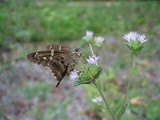
Long-tailed Skipper
Encyclopedia
The Long-tailed Skipper (Urbanus proteus) is a spread-winged skipper
butterfly found throughout tropical and subtropical America, south to Argentina and north into the southern part of the United States of America. It cannot live in areas with prolonged frost. It is a showy butterfly, with wings of light brown tinted with iridescent blue, and two long tails extending from the hindwings. The robust body is light blue dorsally. It has a large head, prominent eyes, and a wingspan between 4.5 and 6 centimeters.


The caterpillar of this skipper is a common pest of crops, especially bean
s, in the southern United States. For this reason, it is sometimes called the bean leafroller in that area. The caterpillars are also known to attack ornamental plants in the legume family such as wisteria
and butterfly pea
. The caterpillars feed on leaves and then roll the leaves around themselves, lining the cavity with silk, to pupa
te. The adults feed on nectar from flowers.
Spread-winged Skippers
Spread-winged skippers, Pyrginae, are a subfamily of the skipper butterfly family . The subfamily was established by Hermann Burmeister in 1878...
butterfly found throughout tropical and subtropical America, south to Argentina and north into the southern part of the United States of America. It cannot live in areas with prolonged frost. It is a showy butterfly, with wings of light brown tinted with iridescent blue, and two long tails extending from the hindwings. The robust body is light blue dorsally. It has a large head, prominent eyes, and a wingspan between 4.5 and 6 centimeters.


Life cycle
It lays white or yellow eggs, singly or in small clusters, which hatch into a caterpillar with a yellowish body and large, dark head. After two to three weeks, the caterpillar forms a pupa. Its pupa is contained in a rolled leaf and covered in fine bluish hairs. The pupa stage may last from one to three weeks, after which the adult emerges.The caterpillar of this skipper is a common pest of crops, especially bean
Bean
Bean is a common name for large plant seeds of several genera of the family Fabaceae used for human food or animal feed....
s, in the southern United States. For this reason, it is sometimes called the bean leafroller in that area. The caterpillars are also known to attack ornamental plants in the legume family such as wisteria
Wisteria
Wisteria is a genus of flowering plants in the pea family, Fabaceae, that includes ten species of woody climbing vines native to the eastern United States and to China, Korea, and Japan. Aquarists refer to the species Hygrophila difformis, in the family Acanthaceae, as Water Wisteria...
and butterfly pea
Clitoria
Clitoria is a genus of flowering plants that are insect pollinated.-Distribution and uses:These plants are native to tropical and temperate areas of the Old World....
. The caterpillars feed on leaves and then roll the leaves around themselves, lining the cavity with silk, to pupa
Pupa
A pupa is the life stage of some insects undergoing transformation. The pupal stage is found only in holometabolous insects, those that undergo a complete metamorphosis, going through four life stages; embryo, larva, pupa and imago...
te. The adults feed on nectar from flowers.

